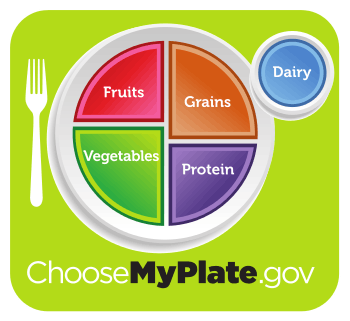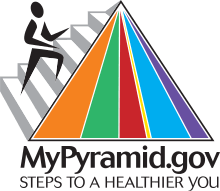MyPlate

MyPlate is the current nutrition guide published by the United States Department of Agriculture, a food circle (i.e. a pie chart) depicting a place setting with a plate and glass divided into five food groups.[1] It replaced the USDA's MyPyramid guide on June 2, 2011, ending 19 years of USDA food pyramid diagrams.[2] MyPlate will be displayed on food packaging and used in nutrition education in the United States.
Background
MyPlate is the latest nutrition guide from the USDA. The USDA's first dietary guidelines were published in 1894 by Dr. Wilbur Olin Atwater as a farmers' bulletin.[3] Since then, the USDA has provided a variety of nutrition guides for the public, including the Basic 7 (1943–1956), the Basic Four (1956–1992), the Food Guide Pyramid (1992–2005), and MyPyramid (2005–2013).
Many other governments and organizations have created nutrition guides. Some, like the United Kingdom's Eatwell Plate,[4] the Australian Guide to Healthy Eating,[5] and the American Diabetes Association's Create Your Plate system,[6] also use plate diagrams.
Guidelines
MyPlate is divided into sections of approximately 30 percent grains, 40 percent vegetables, 10 percent fruits and 20 percent protein, accompanied by a smaller circle representing dairy, such as a glass of milk or a yogurt cup.
MyPlate is supplemented with additional recommendations, such as "Make half your plate fruits and vegetables", "Switch to 1% or skim milk", "Make at least half your grains whole", and "Vary your protein food choices".[7] The guidelines also recommend portion control while still enjoying food, as well as reductions in sodium and sugar intakes.[1]
In unveiling MyPlate, First Lady Michelle Obama said, "Parents don't have the time to measure out exactly three ounces of chicken or to look up how much rice or broccoli is in a serving. ... But we do have time to take a look at our kids' plates. ... And as long as they're eating proper portions, as long as half of their meal is fruits and vegetables alongside their lean proteins, whole grains and low-fat dairy, then we're good. It's as simple as that."[8]
National strategic partners
The USDA has created partnerships with a number of organizations to help promote the messages of MyPlate and spread the reach as far and wide as possible. These partners consist of companies/organizations national in scope and reach that have agreed to "promote nutrition content in the context of the entirety of the Dietary Guidelines for Americans".[9]
Reception

MyPlate was widely received as an improvement on the previous MyPyramid icon, which had been criticized as too abstract and confusing.[10][11][12] The 50-percent emphasis on fruits and vegetables, as well as the simplicity and understandability of the plate image, were particularly praised.
Some critics said the protein section is unnecessary, given that protein is available from other food groups, and Americans on average already eat enough; however, meat would not fit in any of the other food groups. The dairy section was criticized by some as similarly dispensable. An additional critique was that the icon is too simple, missing opportunities for additional dietary advice, such as distinctions between healthy and unhealthy proteins or guidance on good fats and bad fats.[10][13]
The Harvard School of Public Health (HSPH) released their own adjusted and more detailed version of MyPlate, called the Harvard Healthy Eating Plate, in response. Harvard's plate features a higher ratio of vegetables to fruits, adds healthy oils to the recommendation, and balances healthy protein and whole grains as equal quarters of the plate, along with recommending water and suggesting sparing dairy consumption. HSPH Chair of the Department of Nutrition, Walter Willett, criticized MyPlate, saying: "unfortunately, like the earlier U.S. Department of Agriculture pyramids, MyPlate mixes science with the influence of powerful agricultural interests, which is not the recipe for healthy eating".[14] The Harvard plate also contains a recommendation for physical activity.
References
- 1 2 "USDA's MyPlate". United States Department of Agriculture. Retrieved 2 June 2011.
- ↑ "Nutrition Plate Unveiled, Replacing Food Pyramid". The New York Times. 2 June 2011. Retrieved 2 June 2011.
- ↑ "Dietary Recommendations and How They Have Changed Over Time" (PDF). America's Eating Habits: Changes and Consequences. United States Department of Agriculture. May 1999. Retrieved 2 June 2011.
- ↑ "The eatwell plate". National Health Service. Retrieved 3 June 2011.
- ↑ "The Australian Guide to Healthy Eating - Enjoy a Variety of Foods Every Day". Australian Government Department of Health and Ageing. Retrieved 3 June 2011.
- ↑ "Create Your Plate". American Diabetes Association. Retrieved 3 June 2011.
- ↑ "Let's eat for the health of it" (PDF). United States Department of Agriculture. Retrieved 2 June 2011.
- ↑ Sweet, Lynn (2 June 2011). "Michelle Obama hypes icon switch: Bye food pyramid, hello food plate. Transcript". Chicago Sun-Times. Retrieved 6 June 2011.
- ↑ "USDA MyPlate National Strategic Partners". ChooseMyPlate.gov. Retrieved 7 November 2012.
- 1 2 Carman, Tim (2 June 2011). "Michelle Obama and USDA unveil nutritional plate icon". The Washington Post. Retrieved 3 June 2011.
- ↑ Hellmich, Nanci (3 June 2011). "USDA serves nutrition guidelines on 'My Plate"". USA Today. Retrieved 3 June 2011.
- ↑ "Pyramid tossed, dinner plate is new U.S. meals plan". Reuters. 2 June 2011. Retrieved 3 June 2011.
- ↑ Kotz, Deborah (2 June 2011). "New food plate icon: will it change how you eat?". The Boston Globe. Retrieved 3 June 2011.
- ↑ Datz, Todd (14 September 2011). "Harvard serves up its own 'Plate'". Harvard Gazette. Retrieved 31 January 2012.